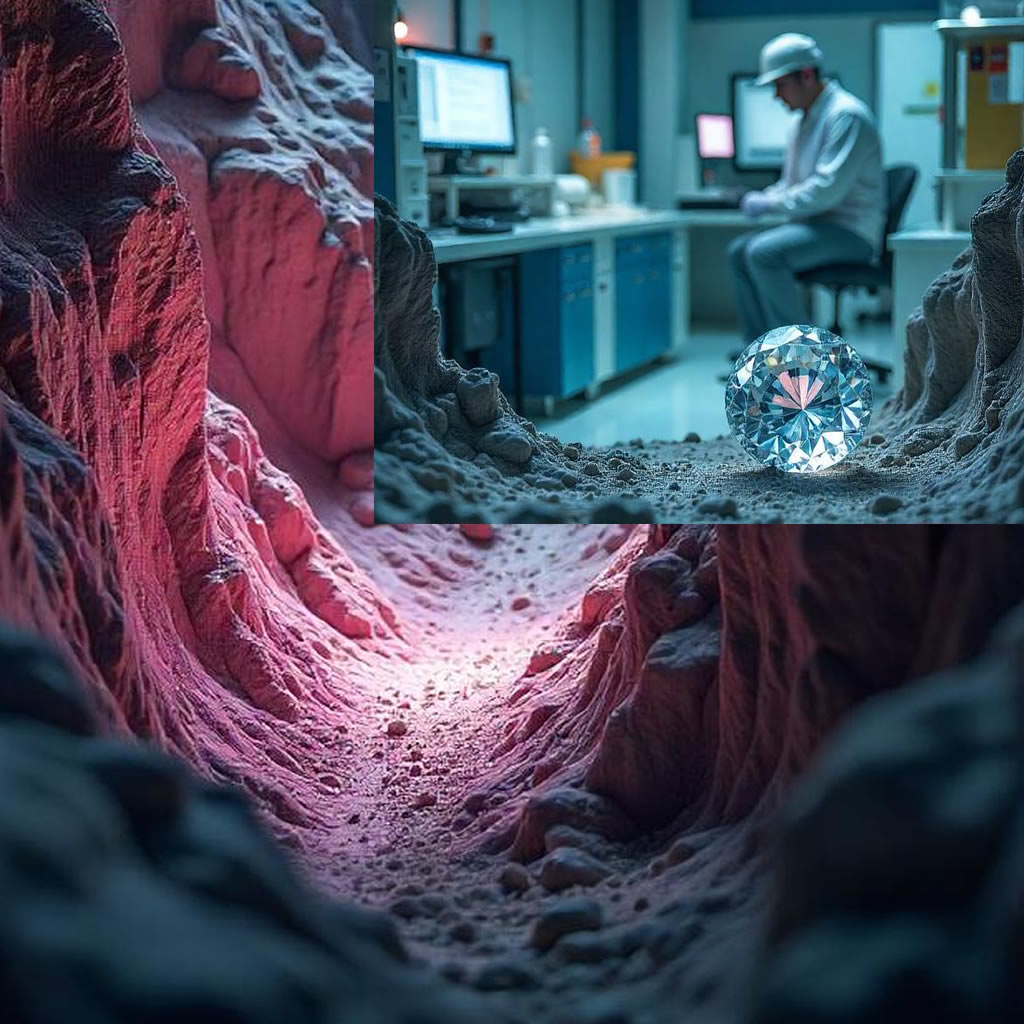Lab-grown diamonds have moved from niche to mainstream. They look the same as mined diamonds, cost less, and are marketed as the more sustainable option. But are they really better for the environment?
This question matters more than ever. Consumers are becoming more aware of how their purchases affect the planet. The diamond industry—long criticized for its environmental and ethical issues—is now under pressure to change. That’s where lab-grown diamonds come in.
In this article, we’ll compare the environmental impact of lab-grown diamonds and mined diamonds, focusing on facts—not hype..

Category | Mined Diamonds | Lab-Grown Diamonds |
Land Disruption | High | None |
Water Use | High | Low |
Energy Use | High (diesel, coal) | High (varies by energy source) |
CO₂ Emissions | ~160 kg per carat | ~20–60 kg per carat |
Pollution Risk | Significant | Low |
Ethical Issues | Often present | Minimal |
*Lab-Grown vs. Mined Diamonds – Environmental Impact
How Mined Diamonds Affect the Environment
Mining diamonds is a resource-heavy process. Whether it’s open-pit or underground mining, the impact on ecosystems is significant.
Land Disruption and Habitat Loss
Diamond mines can span hundreds of acres. Land has to be cleared, ecosystems destroyed, and topsoil removed. In places like Canada and Russia, mining has disrupted fragile environments that take decades to recover.
Water Use and Pollution
Mining uses a lot of water—for processing ore, controlling dust, and separating diamonds. In dry regions, this strains local water supplies. Runoff from mines can also pollute nearby rivers and groundwater with heavy metals and other contaminants.
Energy Consumption and Carbon Emissions
Traditional mining operations use diesel-powered machinery and rely on electricity from fossil fuels. According to a 2019 report by Trucost, commissioned by the Diamond Producers Association, mined diamonds generate around 160 kg of CO₂ per carat.
Social and Ethical Concerns
Beyond the environment, mined diamonds come with a history of human rights issues, including conflict diamonds (also called “blood diamonds”). While the Kimberley Process was created to limit this, it’s not foolproof.
How Lab-Grown Diamonds Are Made
Lab-grown diamonds are real diamonds, just made in a lab instead of pulled from the earth. Two main methods are used:
1. HPHT (High Pressure, High Temperature)
This process mimics the natural conditions under which diamonds form. A tiny diamond seed is placed in carbon and subjected to intense pressure (over 1.5 million psi) and heat (above 1,300°C). The carbon crystallizes around the seed, forming a diamond.
2. CVD (Chemical Vapor Deposition)
CVD involves placing a diamond seed in a sealed chamber filled with carbon-rich gas (like methane). The gas is heated into plasma, and carbon atoms build up on the seed layer by layer. This method generally uses less energy than HPHT and allows for better control over diamond quality.
Energy Use Matters
Both methods require a lot of electricity. But here’s the key point: if the lab runs on renewable energy, the environmental impact drops fast. Labs powered by coal or natural gas still carry a hefty carbon footprint.
Some producers—like Diamond Foundry—claim to be carbon-neutral by using hydropower or solar energy. Others don’t disclose their energy sources at all.
Environmental Impact of Lab-Grown Diamonds
Lab-grown diamonds avoid many of the worst parts of mining, but they’re not impact-free.
Energy Use
Growing a diamond takes a lot of electricity—especially with the HPHT method. A 2022 report by S&P Global found that lab-grown diamonds can use up to 250 kWh per carat, depending on the production method and country. That’s roughly the same energy a U.S. home uses in a week.
If that electricity comes from renewables, the carbon footprint is low. If it comes from coal or gas, it can rival or even exceed that of mined diamonds.
Carbon Emissions
The same Trucost report mentioned earlier estimated that lab-grown diamonds produce around 20 to 60 kg of CO₂ per carat—much lower than mined diamonds, but only if clean energy is used.
Land and Water Use
This is where lab-grown diamonds clearly win. No land excavation, no deforestation, and minimal water use. Labs are usually located in industrial zones, not fragile ecosystems.
Pollution and Waste
There’s no toxic runoff or tailings, but labs do use chemicals and create some industrial waste. It’s far easier to manage and contain in a lab than in a mine, though.

In Short:
- Lower land and water impact
- Lower carbon footprint (if renewables are used)
- Still energy-intensive
Certifications and Greenwashing
As lab-grown diamonds grow in popularity, so do big marketing claims—some true, some not.
Watch Out for Greenwashing
Some brands call their diamonds “eco-friendly” or “carbon neutral” without showing proof. Others claim zero environmental impact, which just isn’t possible. Energy is always used. Chemicals are involved. Unless they’re showing real data, take those claims with a grain of salt.
Look for Third-Party Certifications
If a company really cares about sustainability, they’ll get independent verification. A few legit certifications to look for:
- SCS Global Services – Offers a “Sustainably Rated Diamond” certification that looks at the full supply chain. Covers carbon emissions, water use, and ethics.
- Carbon Trust – Certifies carbon footprint claims. If a diamond is labeled “carbon neutral,” this is one of the more credible ways to verify it.
- Climate Neutral Certified – Focuses on emissions and offsetting. Not diamond-specific, but relevant for lab operations.
Transparency Is Key
The best producers publish detailed sustainability reports. They show energy sources, emissions per carat, and their offset programs (if any). If you can’t find this info, assume the worst.
Conclusion
Lab-grown diamonds usually have a smaller environmental footprint than mined ones—especially when made with renewable energy. They use less water, don’t dig up land, and avoid many of the social issues tied to mining.
But they’re not “green” by default. Growing diamonds still takes a lot of power, and if that power comes from fossil fuels, the carbon impact can be high.
Mined diamonds, on the other hand, come with heavy environmental and ethical baggage—land damage, pollution, and human rights concerns. Even with better oversight, the core problems remain.
Bottom line: lab-grown diamonds can be the better choice, but it depends on how they’re made. If you care about the environment, look for transparency, credible certifications, and energy source info—not just the marketing.
___________________________________________________________________________
Lab-Grown vs. Mined Diamonds: What to Know
- Land + Water: Lab-grown wins—no digging, less water.
- Carbon Footprint: Depends on energy source. Labs using renewables are cleaner.
- Pollution: Mining causes more waste and runoff.
- Ethics: Lab-grown avoids conflict zones and human rights issues.
- Watch out: Not all lab diamonds are clean—check for real certifications.
Sources
- Trucost / Diamond Producers Association (2019): “Total Clarity: The Reality of the Diamond Supply Chain”
https://www.diamondproducers.com/total-clarity/ - S&P Global (2022): “The Carbon Footprint of Lab-Grown Diamonds”
https://www.spglobal.com/esg/insights/ - SCS Global Services – Certified Sustainability Rated Diamonds: https://www.scsglobalservices.com
- Carbon Trust – Product Carbon Footprint Certification: https://www.carbontrust.com
- Diamond Foundry Sustainability Statement: https://diamondfoundry.com/sustainability